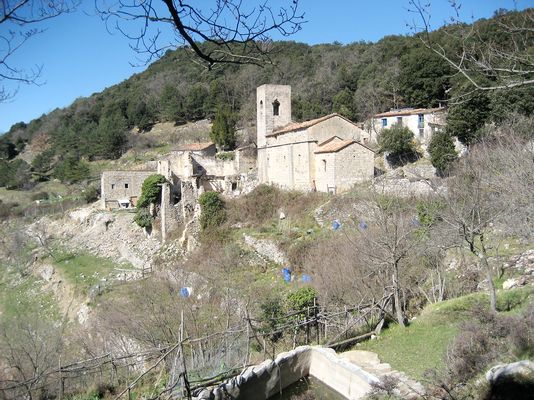A medieval town perched on a 50-meter-high basalt cliff, formed by ancient lava flows. Its stone houses line narrow streets above the Fluvià river.
Castellfollit de la Roca perches on a 50-meter basalt cliff created by ancient lava flows where the Fluvià and Toronell rivers join. Walk by the Sant Salvador Church, first built in the 13th century, look down from Josep Pla Square at the steep drop below, and wander through tight lanes paved with volcanic stone. The village sits inside La Garrotxa Volcanic Zone Natural Park, surrounded by apple orchards and a working basalt quarry—Spain’s only active site of its kind.
The Basalt Cliff and How It Formed
The cliff under Castellfollit stretches almost a kilometer and took shape from two volcanic eruptions more than 200,000 years ago. Lava from Batet de la Serra and Sant Joan les Fonts cooled into stacked basalt layers that now hold up the village. During the Middle Ages, the cliff’s height helped defend against invaders, which is why people built here. Today, the quarry at the base still cuts basalt blocks, a trade recorded here since the 1880s. Follow riverside paths to watch workers extract stone and examine the cliff’s rough, uneven surfaces.
Sant Salvador Church and the Old Town’s Streets
Tight cobblestone alleys and small squares fill the old town, with buildings made from dark volcanic rock. Sant Salvador Church, rebuilt several times since the 13th century, stands near the cliff’s edge. Its square bell tower and late Renaissance design rise above the valley. Inside, white walls and wooden benches create a plain space, unlike the steep drop visible through the windows. Behind the church, stone-walled gardens grow vegetables, reflecting how villagers once relied on their own crops.
Josep Pla Square and Views of the Valley
From Josep Pla Square at the cliff’s eastern tip, you see the Fluvià River valley and volcanic hills around it. Lean over the railing to spot the Fluvià and Toronell meeting 50 meters down, with hawks flying above. Houses here sit inches from the cliff’s edge, showing how little space the village has. Visit at sunrise or sunset to photograph the basalt without harsh shadows. For a full view of the cliff and nearby volcanoes, book a hot air balloon ride that also takes you over the Pyrenees foothills.
La Garrotxa Volcanic Zone Natural Park
This park holds over 40 inactive volcanoes and trails winding through forests and old lava fields. The Volcano Trail links Castellfollit to Olot and Sant Joan les Fonts, passing stone bridges, collapsed lava tubes, and farms with grazing sheep. Join a guided walk to learn how volcanic soil helps oak trees and truffle fungi thrive. Hike the 8-kilometer path to Cós Sanctuary for a clear view of Castellfollit’s cliff and the valleys around it.
Festivals and Weekly Markets
Time your trip for the Festa Major on the third Sunday of September, when the town hosts live bands, circle dances, and shared dinners. During Easter week, the Germandat festival includes parades in medieval clothes and plays about local history. On August 16, Sant Roc Day brings puppet shows and craft stalls to Sant Roc Square. Every Saturday, farmers sell apples, Garrotxa cheese, and cured meats near the Town Hall. These events let you taste local dishes and see Catalan customs up close.
The Cold Cuts Museum and Pont Trencat
The Museu de l’Embotit, opened in 1993, displays old sausage-making tools, spice grinders, and posters from Catalan meat shops. Try pressing herbs into salt rubs or watch videos showing how families dried hams in mountain air. Walk 15 minutes from the village to Pont Trencat, a broken bridge over the Fluvià River. Its crumbling arches, left unfinished after floods in the 1920s, frame the basalt cliff behind them—a good spot for photos.
How to Reach Castellfollit de la Roca
The village lies 49 kilometers north of Girona and 122 kilometers from Barcelona. Take a direct bus from Girona’s station; the 75-minute ride winds through farmland and volcanic hills. From Barcelona, drive via AP-7 and GI-542 or take a train to Girona and switch to a bus. Many visitors pair Castellfollit with stops in Olot’s lava museums or Besalú’s 12th-century bridge. Parking near the old town fills quickly, so use the lot by the sports complex or arrive before 10 a.m.



















